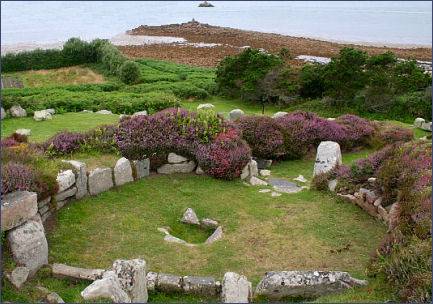Halangy Down Iron Age Village
OS grid reference :-SV 9012
 Halangy Down Village is a Iron Age to Roman settlement that lies at the south-west edge of Halangy Down on the island of St. Mary's. It is siuated below Bant's Carn, an entrance grave dating from the Bronze Age.
Halangy Down Village is a Iron Age to Roman settlement that lies at the south-west edge of Halangy Down on the island of St. Mary's. It is siuated below Bant's Carn, an entrance grave dating from the Bronze Age.
The village was occupied from the Iron Age through to the Roman settlement of the British Isles. The inhabitants of the settlement probably lived in much the same manner as their Bronze Age predecessors.
Excavations of the site took place in the 1950s and revealed a complex of 11 inter-connecting stone-built houses, many of them simple oval structures which probably had a conical thatched roof. Stone-lined drains, hearths and cupboards constructed from the thickness of the walls were uncovered.
One dwelling among the eleven is significantly larger than the others, measuring 27 metres long by 14.5 metres wide, it revealed demarcations for three rooms and a long curved entrance passage.
The houses of the village showed signs of repair and alteration, suggesting that the settlement had a long period of occupation and sustained a functioning economy. Most of the stones from the Iron Age village were removed for other buildings in the nineteenth century, only the foundations remain. The village of Halangy Down is now in the care of English Heritage.
Directions
The site can be accessed from a track leading off the B road by the Telegraph Tower, or by taking the coastal path from Hugh Town or Porthloo